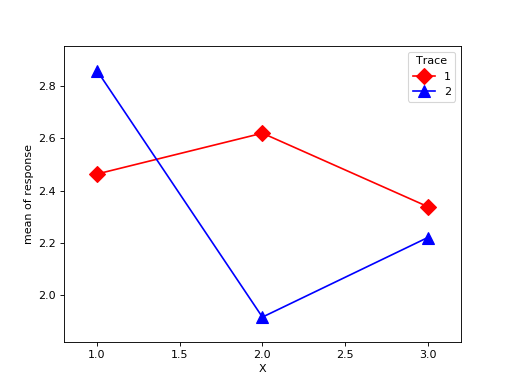statsmodels.graphics.factorplots.interaction_plot¶
-
statsmodels.graphics.factorplots.interaction_plot(x, trace, response, func=<function mean>, ax=None, plottype='b', xlabel=None, ylabel=None, colors=None, markers=None, linestyles=None, legendloc='best', legendtitle=None, **kwargs)[source]¶ Interaction plot for factor level statistics.
Note. If categorial factors are supplied levels will be internally recoded to integers. This ensures matplotlib compatibility.
uses pandas.DataFrame to calculate an aggregate statistic for each level of the factor or group given by trace.
- Parameters
- xarray_like
The x factor levels constitute the x-axis. If a pandas.Series is given its name will be used in xlabel if xlabel is None.
- tracearray_like
The trace factor levels will be drawn as lines in the plot. If trace is a pandas.Series its name will be used as the legendtitle if legendtitle is None.
- responsearray_like
The reponse or dependent variable. If a pandas.Series is given its name will be used in ylabel if ylabel is None.
- func
function Anything accepted by pandas.DataFrame.aggregate. This is applied to the response variable grouped by the trace levels.
- plottype
str{‘line’, ‘scatter’, ‘both’},optional The type of plot to return. Can be ‘l’, ‘s’, or ‘b’
- ax
axes,optional Matplotlib axes instance
- xlabel
str,optional Label to use for x. Default is ‘X’. If x is a pandas.Series it will use the series names.
- ylabel
str,optional Label to use for response. Default is ‘func of response’. If response is a pandas.Series it will use the series names.
- colors
list,optional If given, must have length == number of levels in trace.
- linestyles
list,optional If given, must have length == number of levels in trace.
- markers
list,optional If given, must have length == number of levels in trace
- **kwargs
These will be passed to the plot command used either plot or scatter. If you want to control the overall plotting options, use kwargs.
- Returns
- fig
Figure The figure given by ax.figure or a new instance.
- fig
Examples
>>> import numpy as np >>> np.random.seed(12345) >>> weight = np.random.randint(1,4,size=60) >>> duration = np.random.randint(1,3,size=60) >>> days = np.log(np.random.randint(1,30, size=60)) >>> fig = interaction_plot(weight, duration, days, ... colors=['red','blue'], markers=['D','^'], ms=10) >>> import matplotlib.pyplot as plt >>> plt.show()
(Source code, png, hires.png, pdf)
